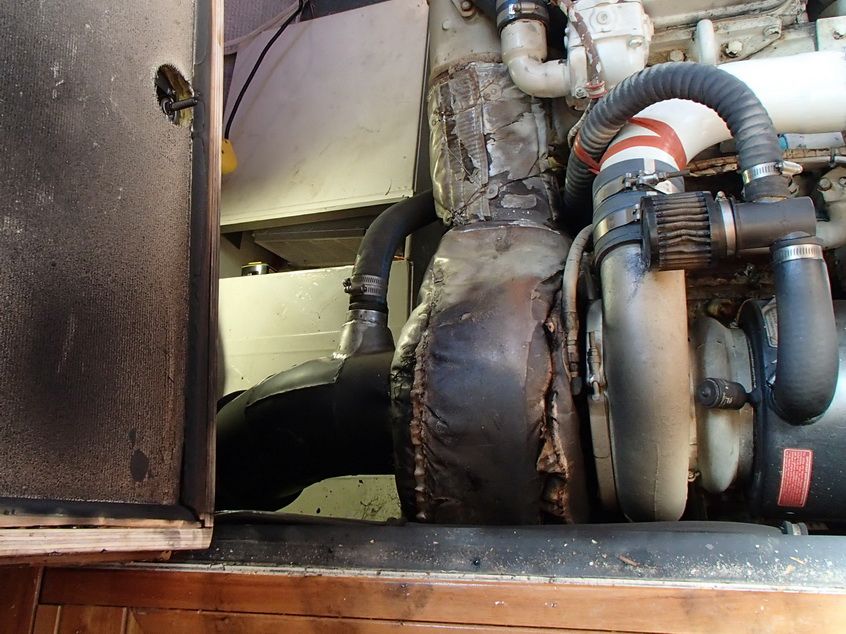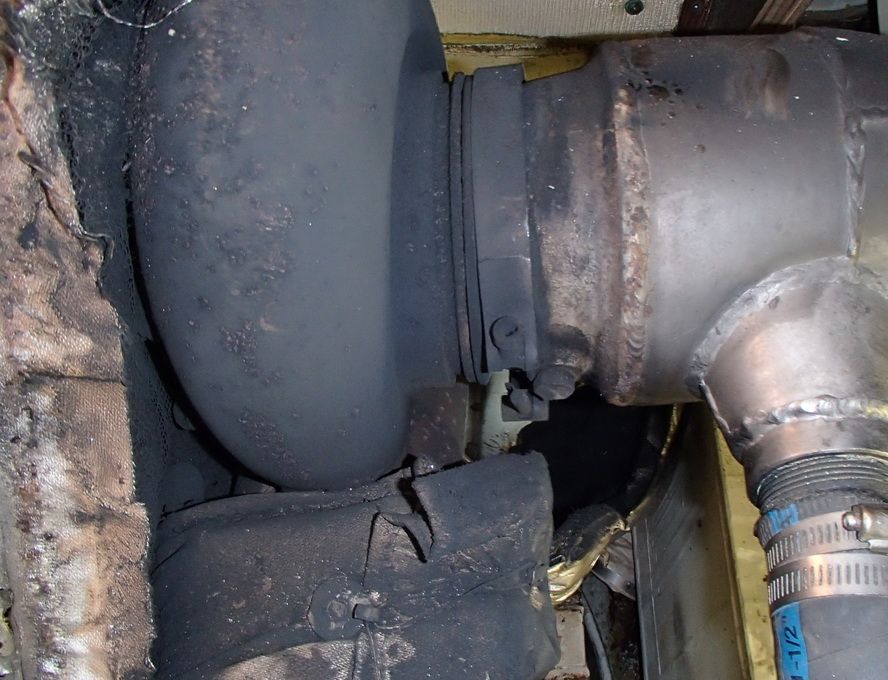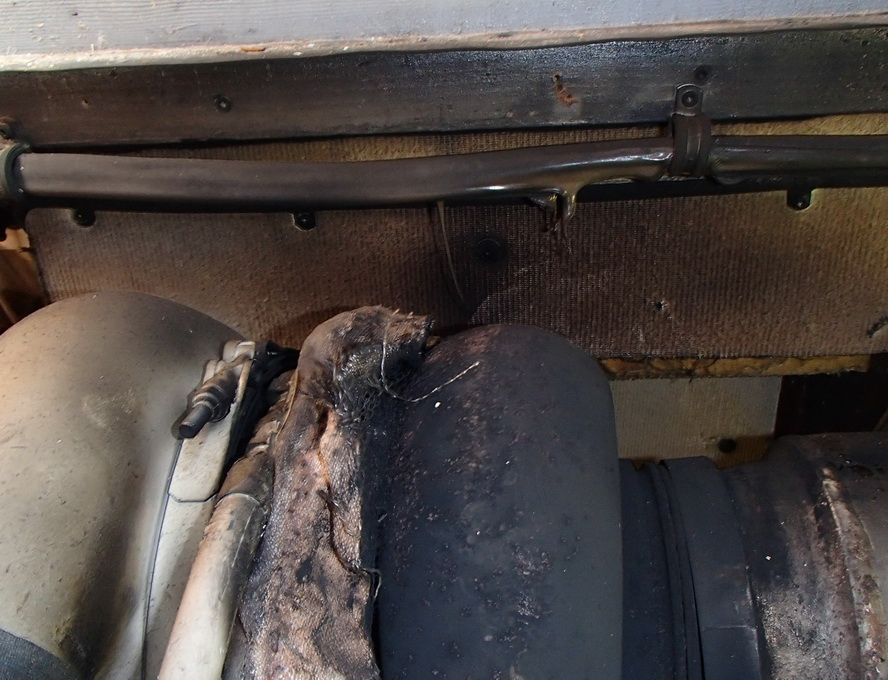I was working in the engine room this morning and did something I have not done in a while. I lifted the hatch above the port engine, Covington 671ti, and discovered soot. When I reached down and grasped the Stainless pipe connected to the turbo, I noticed that it was very loose, until I pushed it back into the turbo.
I removed the turbo blanket and discovered that the ring that holds the pipe in place was loose and that the bolt to secure it was broken.
It looks serious and put off enough heat to melt a nearby wire.
I will be wondering and worrying over this until I find out what I am dealing with and what needs to be done to fix it. Your advice over just what needs to be done to fix this correctly will be appreciated. Obviously the ring that secures the pipe to the turbo needs to be replaced. What else will there probably be?
Thanks,
Welcome to the Hatteras Owners Forum & Gallery. Sign Up or Login
+ Reply to Thread
Results 1 to 10 of 29
-
Exhaust Leak at Turbo exhaust pipe connection - What am I dealing with?
Regards,
Vincent Castigliola
Lilly Marie - 43 DC 1983
Pascagoula, Mississippi
Rather than history as a peaceful continuum interrupted by war, “For the first time in the nation's history men in authority are talking about an "emergency" without a foreseeable end" _ C. Wright Mills 1956
-
08-03-2013 02:07 PM #2
 Senior Member
Senior Member
- Join Date
- Mar 2013
- Posts
- 160
Re: Exhaust Leak at Turbo exhaust pipe connection - What am I dealing with?
it looks like the bolt failed, , those turbos put off a lot of heat , I couldn't tell but it looks like you could just replace the bolt . are they connected using a round barrel on both sides of the clamp ends ? A new clamp should do the trick .
-
Re: Exhaust Leak at Turbo exhaust pipe connection - What am I dealing with?
Thanks Paul,
If replacing the clamp is all I need, that would be great. I wonder if there is a gasket between the turbo and the pipe which needs to be replaced?Regards,
Vincent Castigliola
Lilly Marie - 43 DC 1983
Pascagoula, Mississippi
Rather than history as a peaceful continuum interrupted by war, “For the first time in the nation's history men in authority are talking about an "emergency" without a foreseeable end" _ C. Wright Mills 1956
-
Re: Exhaust Leak at Turbo exhaust pipe connection - What am I dealing with?
You're lucky you didn't light the boat on fire; the exhaust coming out of there is at roughly 1000F!
Check the exhaust bracing and make sure you didn't break the clamp due to the pipe coming out the back being improperly braced and exerting enough force to break the clamp. Fix any problems you find there first or you'll just break another one.
Most of the older designs did not use a gasket. Some of the newer setups do. The older ones relied on the flanges being exactly true and undamaged. The problem with leaks like this is that the gas is corrosive and will erode the mating surfaces quite quickly.
The clamp obviously needs to be replaced. But before you just replace it, check the surface of the pipe and turbo outlet and see if it is eroded or not (you need to clean it up first obviously.) A small amount of erosion can be dealt with using Silkolene on the flange area; it's a high-temperature sealant (don't even think about using something like RTV in there!); it's pretty expensive stuff but it's what you want to use. On a VERY thin coating is required; it "cooks" when it gets hot the first time and expands, setting into place and filling small amounts of eroded space. If the flanges are badly pitted or if the Silkolene fails to seal it you're looking at a turbo and/or pipe replacement.
The bad news is that it's very likely soot has been ingested into the engine. The wear that has caused, if it happened, has happened and will shorten the service life of the engine; nothing you can do about that. If the air filter element on the front of that airsep is blackened with soot replace it; you can try cleaning it but you won't be completely effective in getting it all out. If you want to take a crack at cleaning it a cleaner with butyl cellusolve in it will dissolve the soot, but don't get that crap on your hands -- it's nasty stuff -- and make sure you get it all out of the element before you re-oil it. Look at the compressor wheel on the turbos looking down the inlet and see how much build-up you have there as well. There are people who will advise spraying (very lightly!) water down the intake with the engine running to clean compressor wheels; I disagree. Unless the compressor is badly compromised I'd probably leave it alone, assuming the exhaust side is ok and seals back up. If it is badly compromised consider removing the compressor housing (it does come off fairly easily) and manually clean the wheel and housing area -- just make sure you get it all off if you clean any of it, that you don't use anything that could damage the wheel itself and that you pay attention during disassembly and reassembly because if you don't any imbalance or damage to the wheel that occurs has a high probability of grenading the turbo the next time the engine is run. Do not remove the compressor wheel or loosen the nut on the shaft; the exact position of the wheel on the shaft is part of the balancing that was done when it was originally assembled.
Assuming 6-71TIs (what it looks like) the next task is to check the intercooler and see how badly it's plugged up and, if fouled (good chance it is), remove and clean it.
Finally, pull the airbox covers and have a look inside. If you're lucky the airbox is not full of what looks like (and in fact is) oily carbon clumps. If there are some deposits but they're not up to the level of the cylinder ports, LEAVE IT ALONE. If, on the other hand, there are deposits up to the level of the ports or (worse) above that level and in the ports, or if the airbox drains are plugged with crud consideration has to be given to cleaning some or all of it out. This is EXTREMELY tricky to do as if any of that stuff gets loose and into the cylinders or worse, under the compression rings and is trapped between the compression and oil control rings it will act exactly like sandpaper on the cylinder walls. Larger pieces could conceivably get between the piston and cylinder head or valves and be pretty much like a hydrolock with really bad results.
For obvious reasons don't run the boat until you've fixed it -- a fire in the engine room is definitely not on the list of things you want to have happen and you got close.Last edited by Genesis; 08-03-2013 at 02:25 PM.
http://www.denninger.net - Home page with blog links and more
http://market-ticker.org - The Market Ticker
-
Re: Exhaust Leak at Turbo exhaust pipe connection - What am I dealing with?
Genesis,
Thanks for the detailed and helpful assessment. It is a 671ti.
Interestingly, the plywood crutch support for the port engine exhaust is in place and has not moved. On the other hand, the crutch for the stbd exhaust came loose and had to be reset. No problem with the stbd exhaust so far.
I found replacement clamps online and see there is a 5.25" diameter and a 5.75" diameter clamp listed with no indication which clamp is for which engine. Guess I can measure, and hopefully pick the right spaces to measure.
I respect concerns over a boat fire and wonder if the turbo blanket should be replaced?
Regards,Regards,
Vincent Castigliola
Lilly Marie - 43 DC 1983
Pascagoula, Mississippi
Rather than history as a peaceful continuum interrupted by war, “For the first time in the nation's history men in authority are talking about an "emergency" without a foreseeable end" _ C. Wright Mills 1956
-
Re: Exhaust Leak at Turbo exhaust pipe connection - What am I dealing with?
Karl, Is that vacuum limiter on the Airsep housing closed?
Bobk
-
Re: Exhaust Leak at Turbo exhaust pipe connection - What am I dealing with?
Closed? You mean closed to airflow? It does flow air when limiting vacuum (when it is pulled open by the vacuum level.) It doesn't look too bad. You can't see the main element on the front of the airsep from the pictures; that's the one to be concerned about.
http://www.denninger.net - Home page with blog links and more
http://market-ticker.org - The Market Ticker
-
08-03-2013 05:02 PM #8
 Senior Member
Senior Member
- Join Date
- Apr 2008
- Posts
- 494
Re: Exhaust Leak at Turbo exhaust pipe connection - What am I dealing with?
Do a google search for Silkolene. Get it from a motocross/ motorcycle shop. They sell it for 1/3 the price that a marine exhaust shop asks. It is good stuff.
-
Re: Exhaust Leak at Turbo exhaust pipe connection - What am I dealing with?
You are super lucky the boat didn't burn!!! When the 46C's came out the turbo supports were failing. I was on a 46 that caught fire 40 some miles offshore Cape May NJ back in the 70s.We were swimming within 10 minutes of the first indication something was wrong. Oil fed fires are a very bad thing.
"DON'T BELIEVE ANYTHING YOU READ OR HEAR AND ONLY HALF OF WHAT YOU SEE" - BEN FRANKLIN
Endless Summer
1967 50c 12/71n DDA 525hp
ex Miss Betsy
owners:
Howard P. Miller 1967-1974
Richard F Hull 1974-1976
Robert J. & R.Scott Smith 1976-present
-
Re: Exhaust Leak at Turbo exhaust pipe connection - What am I dealing with?
Since the elbow has seperated from the turbo, you really need to take the elbow off and clean the mating surfaces. I have had problems with silkolene and no longer use it.
MTU makes a silicone type black sealant that will take the heat. Use that on the joint.
Clean the outside of the flanges as well. Any burrs on the outside flanges is hard on the new Marmon clamp. Tap the clamp when tightening to make sure it is seated all the way.






 Reply With Quote
Reply With Quote



